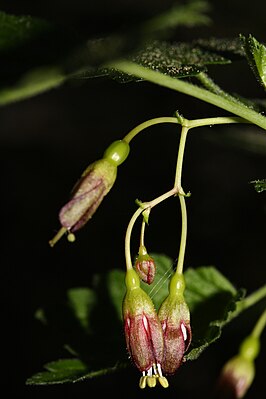Oregon gooseberry
| Oregon gooseberry | ||||||||||||
|---|---|---|---|---|---|---|---|---|---|---|---|---|

Oregon gooseberry blossoms |
||||||||||||
| Systematics | ||||||||||||
|
||||||||||||
| Scientific name | ||||||||||||
| Ribes divaricatum | ||||||||||||
| Douglas |
The Oregon gooseberry ( Ribes divaricatum ; also black honeyberry ) is an upright shrub up to 3 meters high with black or dark red fruits from the gooseberry family (Grossulariaceae). The natural range of the species is in Canada and the United States. The species is rarely cultivated.
description
The Oregon gooseberry is a 1 to 3 meter high shrub with gray to brown, sometimes bristly branches. The nodes are unreinforced or have one to three 5 to 20 millimeters long, often curved back spines. The internodes are unreinforced or have a few spines. The leaves have a 1 to 3 centimeter long, finely hairy and sometimes glandular hairy petiole. The leaf blade is simple, three to five lobed, rounded to almost kidney-shaped, 2 to 3.5 centimeters long with a heart-shaped to rounded base. The lobes are wedge-shaped, serrated with a rounded tip. The upper side of the leaf is almost bald or hairy, the underside is hairy down.
The flowers are solitary or in 2 to 4 cm long clusters of 2 to 4 flowers. The inflorescence spindles are glabrous or finely hairy. The bracts are oval, 1 to 2 millimeters long, glabrous or ciliate. The flower stalks are bald or finely haired and 3 to 12 millimeters long. The flowers are hermaphroditic. The flower cup is inverted-conical, greenish or reddish, glabrous or hairy, 1.5 to 3.5 millimeters long, with horizontally standing, narrow oblong, inverted triangular, 3.4 to 6 millimeter long, non-overlapping tips with a back bent ends. The petals stand upright, they are white, pink or red, 1.2 to 3 millimeters long, wedge-shaped to obovate and not clearly rolled up. The stamens are 2.5 to 3.5 times as long as the petals. The stamens are straight, glabrous and 3.5 to 7 millimeters long. The anthers are cream-colored, 1 millimeter long with a rounded tip. The ovary is bare. The styles are 5 to 11 millimeters long, fused and hairy up to half their length. The fruits are black-red, frosted, round, glabrous with a diameter of 6 to 12 millimeters and are edible.
The number of chromosomes is 2n = 16.
Occurrence and location requirements
The natural range is in the Canadian province of British Columbia and in the US states Oregon , Washington and California . The Oregon gooseberry grows in bogs and swamps in swamp forests, on damp and wet meadows in sunny to light-shaded locations.
Systematics
The Oregon gooseberry ( Ribes divaricatum ) is a species from the genus of currants ( Ribes ) in the gooseberry family (Grossulariaceae). It is assigned in the subgenus Grossularia of the Grossularia section . The species was first scientifically described by David Douglas in 1830 . The generic name Ribes is derived from the Arabic name of a type of rhubarb . The name was adopted for currants in the Middle Ages because of the sour taste of the berries of some species, which is reminiscent of the taste of rhubarb. The specific epithet divaricatum comes from the Latin and means "bulky".
There are three varieties :
- Ribes divaricatum var. Divaricatum with 2 to 3 millimeter long, white petals, 8 to 11 millimeter long style and 4.5 to 7 millimeter long stamens. The flower cup is 1.7 to 2.5 millimeters long.
- Ribes divaricatum var. Parishii (A. Heller) AE Murray with 2 to 3 millimeter long, pink to red petals, 8 to 11 millimeter long style and 4.5 to 7 millimeter long stamens. The flower cup is 2.8 to 3.5 millimeters long.
- Ribes divaricatum var. Pubiflorum pods with 1.2 to 1.7 millimeters, white petals, 5 to 7 millimeters long style and 3.5 to 4.7 rarely 5 millimeter long stamens.
use
The Oregon gooseberry is rarely cultivated.
proof
literature
- Flora of North America Editorial Committee (Ed.): Flora of North America North of Mexico . Volume 8: Magnoliophyta: Paeoniaceae to Ericaceae . Oxford University Press, New York / Oxford a. a. 2009, ISBN 978-0-19-534026-6 , pp. 38 (English).
- Andreas Roloff , Andreas Bärtels: Flora of the woods. Purpose, properties and use. With a winter key from Bernd Schulz. 3rd, corrected edition. Eugen Ulmer, Stuttgart (Hohenheim) 2008, ISBN 978-3-8001-5614-6 , pp. 538-539.
- Jost Fitschen : Woody flora . 12th, revised and expanded edition. Quelle & Meyer, Wiebelsheim 2007, ISBN 3-494-01422-1 , p. 727 .
- Helmut Genaust: Etymological dictionary of botanical plant names. 3rd, completely revised and expanded edition. Nikol, Hamburg 2005, ISBN 3-937872-16-7 (reprint from 1996).
Individual evidence
- ↑ German name according to Roloff et al .: Flora der Gehölze , p. 538 and after Fitschen: Gehölzflora , p. 727
- ↑ a b c d Nancy R. Morin: Ribes divaricatum , in: Flora of North America Editorial Committee (Ed.): Flora of North America North of Mexico . Volume 8: Magnoliophyta: Paeoniaceae to Ericaceae . Oxford University Press, New York / Oxford a. a. 2009, ISBN 978-0-19-534026-6 , pp. 38 (English).
- ↑ a b c d Roloff et al .: Flora of the Woods , pp. 538–539
- ↑ a b c Ribes divaricatum. In: Germplasm Resources Information Network (GRIN). United States Department of Agriculture, accessed June 3, 2012 .
- ↑ Exactly: Etymological Dictionary of Botanical Plant Names, pp. 538–539
- ↑ Exactly: Etymological Dictionary of Botanical Plant Names , p. 213
Web links
Ribes divaricatum. In: The Plant List. Retrieved May 5, 2012 .

